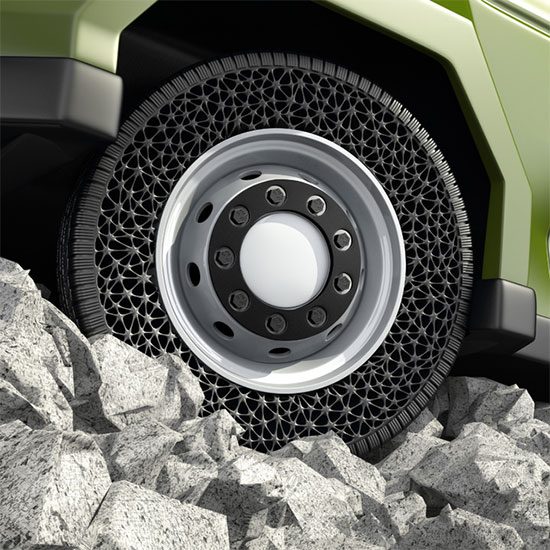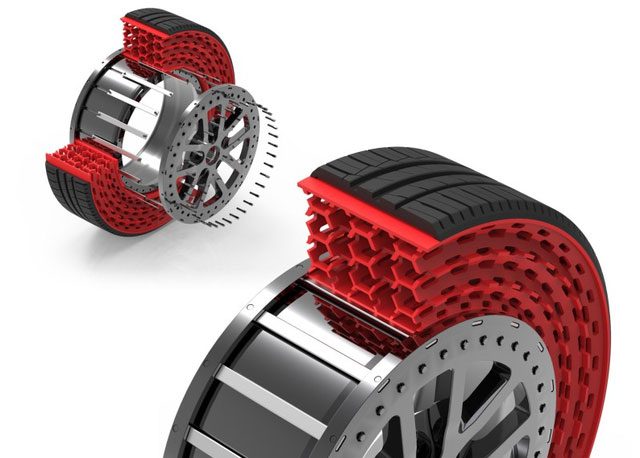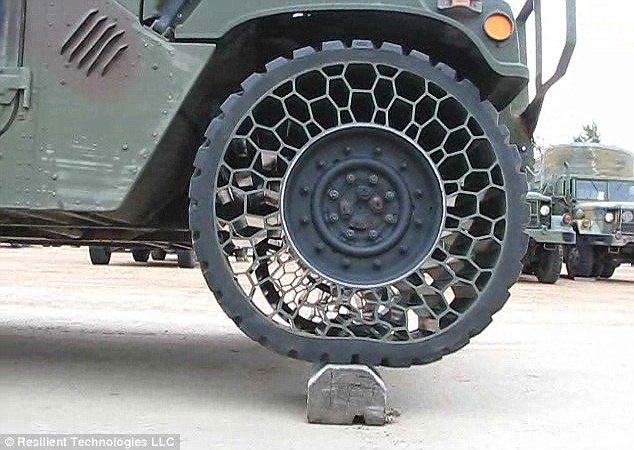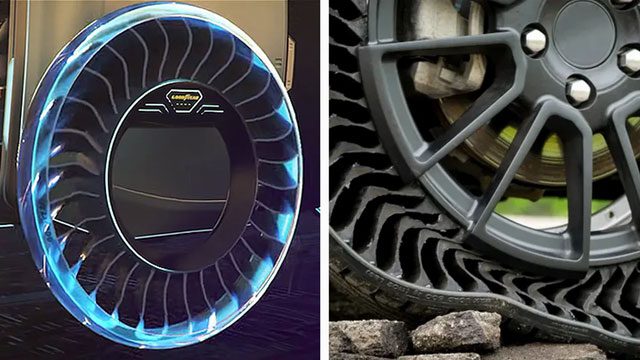Airless tires represent a groundbreaking automotive technology, significantly contributing to environmental protection and sustainable development.
Airless Tires Made from Special Elastic Materials
With the rapid advancement of technology, airless tires are revolutionizing our understanding of vehicle tires. Traditional pneumatic tires are prone to punctures, and under-inflated tires are a common occurrence, posing numerous safety risks while driving. The emergence of airless tires has completely resolved these issues, providing us with enhanced safety and comfort.
Airless tires utilize special elastic materials. Unlike pneumatic tires, they do not rely on air pressure, thus avoiding pressure-related issues and effectively resisting punctures from sharp objects outside.

This groundbreaking technology has significantly improved driving comfort and stability. Airless tires not only reduce impacts and vibrations, enhancing the driving experience, but also improve vehicle handling and stability, thereby reducing risks during maneuvers and increasing driving safety.
This is due to the material of airless tires containing a large number of micropores. When exposed to external stimuli, these micropores automatically contract, preventing fluid leakage and maintaining the integrity of the tire’s interior. This technological breakthrough not only addresses the issue of tire pressure reduction but also greatly improves the wear resistance and puncture resistance of the tires.
Airless tires are safer than traditional pneumatic tires. Due to inadequate tire pressure, pneumatic tires can easily burst while driving, posing serious risks to the lives of the driver and passengers. Airless tires operate independently of air pressure and can effectively avoid this situation. Even if an airless tire is punctured by a sharp object while driving, it does not immediately burst but quickly restores its shape through self-repairing functionality, ensuring stability and safety while driving.

Airless tires provide better traction and are less affected by external factors. Especially in extreme driving situations such as high-speed turns and sudden braking, airless tires can maintain vehicle stability better, minimizing risks during handling and enhancing driving safety.
In addition to higher safety, airless tires also offer a better driving experience. When using traditional pneumatic tires on uneven roads, uneven tire pressure can lead to a bumpy and unstable driving sensation.
Thanks to their special elastic material, airless tires can effectively absorb road impacts, reducing vibrations while driving and providing drivers with a smoother and more comfortable driving experience. These elastic materials can also increase the contact area with the ground, enhancing friction between the tire and the road, while improving stability and control while driving.
This breakthrough technology of airless tires also plays a positive role in environmental protection. During the use of pneumatic tires, frequent checks of tire pressure and inflation are necessary, as inflating can release harmful gases, and flat tires require proper disposal and recycling. Airless tires do not require inflation, do not produce harmful emissions, reduce waste of natural resources, and lessen environmental pressure.

The groundbreaking technology of airless tires uses special elastic materials to address many issues associated with traditional pneumatic tires while enhancing safety and comfort while driving. Although there are still challenges, continuous technological advancements and decreasing costs suggest that airless tires will become an important development trend in the automotive industry in the future.
Principles and Manufacturing Process of Puncture-Resistant Design
Airless tires are an improved tire technology that applies puncture-resistant design to offer drivers a safer and more comfortable driving experience. The principle behind the puncture-resistant design of airless tires is the use of special materials and structures that enable the tires to self-repair. Its structure comprises multiple layers of special materials that can effectively prevent punctures from penetrating the tire, achieving air-tightness and preventing blowouts.

Airless tires are safer than traditional pneumatic tires. (Illustrative image).
The manufacturing process of airless tires is relatively complex, but it can primarily be divided into four steps: material selection, sheet rolling, thermal curing, and trimming. During the production of airless tires, it is essential to select special materials that are elastic and impact-resistant, such as high-performance rubber composites. These materials efficiently absorb impacts and support weight to ensure stable driving performance.
The manufacturing of airless tires involves compressing the selected materials together to form a composite structure. Sheet rolling bonds different materials together using a special adhesive to create the tire frame and tread. During this process, the thickness and distribution of each material layer must be precisely controlled to ensure tire uniformity and stability.
Next, the tire is sent to a curing chamber for heating and curing. Curing is the process where the tire is placed in a high-temperature environment to induce chemical reactions in the materials, enhancing elasticity and hardness. By controlling the temperature and heating time, the tire materials can achieve optimal hardness and elasticity, improving performance and durability during driving.

The manufacturing process of airless tires is relatively complex. (Illustrative image).
Through the trimming process, the tire’s shape and size are created to meet specifications. Trimming occurs in the final stage of tire production, where the tire’s shape is adjusted to specified dimensions and shapes using methods such as cutting and grinding. The trimming process significantly impacts the form and performance of the tire and requires precise control for each tire to ensure consistency and safety.
Airless tires provide drivers with a safer and more comfortable driving experience thanks to their puncture-resistant design. They utilize special materials and structures to enable self-repair and effectively prevent punctures. The production of airless tires involves several processes, including material selection, sheet rolling, thermal curing, and trimming, to ensure the quality and performance of the tires. The groundbreaking technology of airless tires has brought innovation and advancement to the automotive industry, providing drivers with a more comfortable and safer driving experience.
Although airless tires represent a significant technological breakthrough, they have not yet been widely adopted due to certain challenges. For instance, the production costs of airless tires are relatively high and require more advanced technology and materials. The range of use and adaptability of airless tires also has certain limitations, making them suitable for specific vehicle models and driving environments.





















































